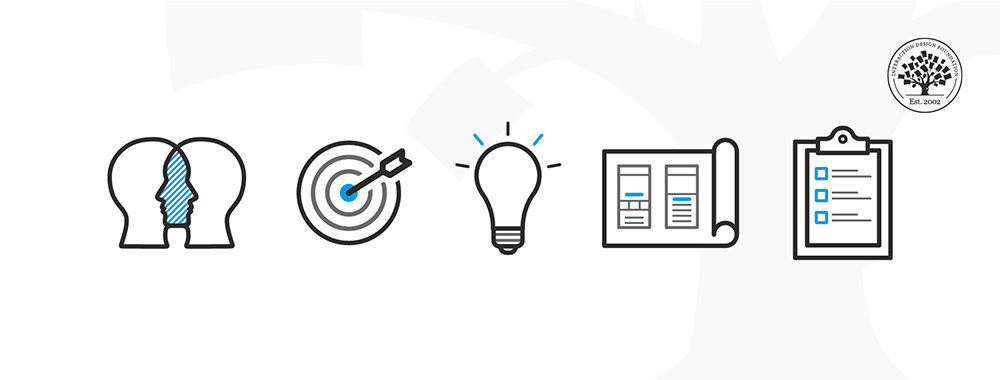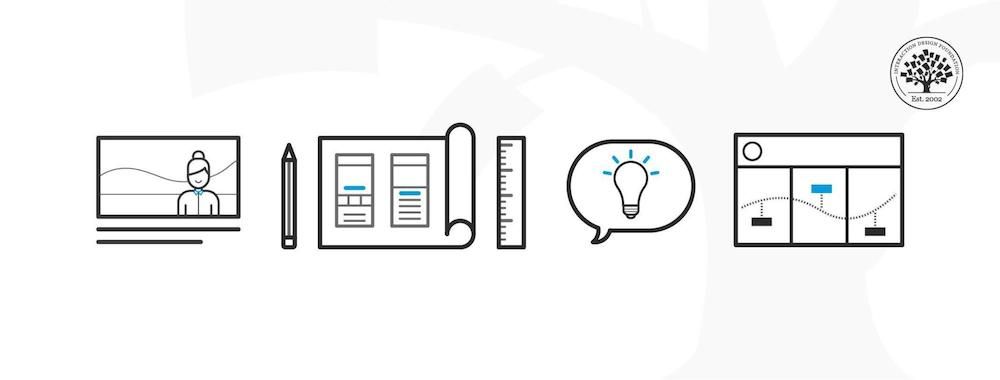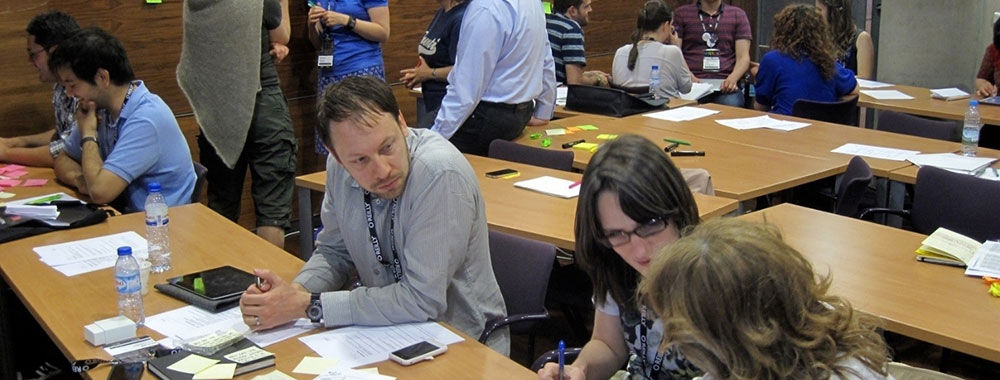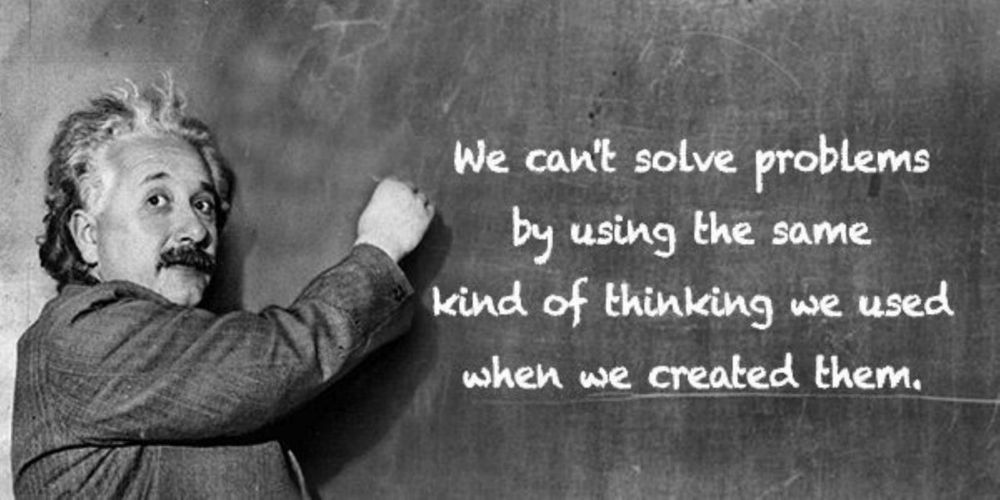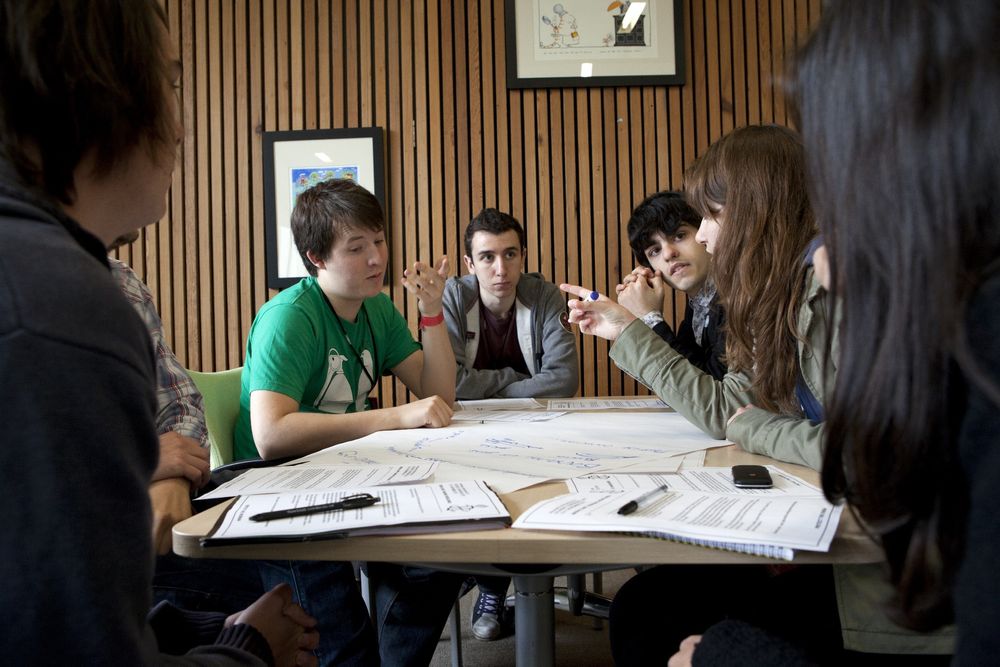“In a world where business is more interested in ‘best practice’ rather than different practice, is it any wonder that products and services, companies and organizations are all beginning to look the same?” the three authors rhetorically ask in ?What If!'s classic book on creativity and innovation, Sticky Wisdom. How to Start a Creative Revolution at Work. They’ve got a vital point there. So, let’s see how we can help you stand apart in your work by learning three new methods—namely, Re-Expression, Revolution, and Random Links. These can help you soar above the humdrum and make users go ‘Wow!’ – not because you’ll have done the ‘done thing’ but because you’ll have done the right thing, by going beyond.
As a designer, thinking creatively and coming up with new ideas go with the territory. Especially to those who have little understanding of how design ‘works’, we tend to get held in the kind of esteem where they see us as wellsprings of creativity, producing great output but still in a similar way to those doing other roles. It’s our job, right? Being considered bottomless supplies of cool ideas might seem flattering, but we know the reality involved in a creative career. Coming up with ideas that are truly groundbreaking can be difficult. We often end up thinking like our competitors. Thinking about things in a completely new way is downright hard, in fact. The reason lies in human nature—we’re wired to fit new information and challenges into our existing assumptions about the world, rather than challenge those assumptions and habits. Getting to a place where you can devise truly innovative ideas takes rising up and out of your normal way of thinking. Don’t worry; this involves quite a bit of fun and no out-of-body experiences.
Why is Innovative Thinking Difficult?
In everyday life, we need to be able to make sense of the world very quickly, without thinking too much about all the various stimuli that we encounter. To do that, we fit new information into mental categories known as schemas. The concept of schemas first appeared in the field of psychology, thanks to the developmental psychology pioneer Jean Piaget. That was in the 1920s, and it has since become a widely recognised term in psychology. You could say that schemas are like our own private theory about how the world works. We need schemas so we don’t have to question everyday assumptions such as the facts that an orange tastes sweet and that we have to stop walking when the traffic light turns red. However, when we set out to challenge our schemas in order to be innovative, they can become rigid. Consequently, overlooking information that might challenge how we think about the world comes all too easily to us. So, when we want to be creative and think new thoughts, we need strategies to challenge our habitual ways of thinking.
Before we explore these, let’s examine more about how schemas work. Understanding schemas will help you challenge your own, and you may well learn more about yourself in the process.
How Schemas Work

© Duncan c., CC BY-NC 2.0
Schemas allow us to make sense of the world, and speedily so; but they can also mean that we overlook alternatives that don’t fit into our ways of thinking.
We humans have schemas for everything we have encountered before, from different types of birds to different types of behavior. If I am walking by the ocean and I hear a bird screeching loudly, I don’t have to examine it more closely to realize that the bird is a seagull. Other information in my ‘seagull schema’ tells me that it is white, grey, and black and has an orange beak. I don’t have to take a closer look at it to know that.
Schemas serve an important function because they allow us to decode the world about us without having to examine everything. Without schemas, even our everyday environment would quickly become a very overwhelming place. The ‘help’ they provide comes at a cost, though. One downside to schemas is that they can be difficult to change; another is that they make us overlook information that does not fit into the schema. If the seagull I heard happened to be blue, I might not even notice. A well-known example of schemas that can become problematic is stereotypes. When we meet someone who looks or dresses a certain way, we immediately have a range of expectations for how we think that person is going to think and behave. Something as simple as whether a person is using an Apple MacBook or a Windows PC makes us have different expectations of that person. Some of our expectations will be correct and others incorrect, but research has shown that we are more likely to notice the things about the person that fit into our existing schemas, and overlook things that do not (see, for example, Bem, 1981). That means that we miss out on new and surprising information. It also has the sad tendency to help an unwary mind write off a person or something based on a single, often superficial, characteristic.

© Alejandro Pinto, CC BY 2.0
Schemas can lead to stereotypes. Something as simple as whether you use a MacBook or a PC will lead people to assume things about who you are and what you do. Not all MacBook users are creative types or ardently progressive in their politics; likewise, not all PC users are unswerving traditionalists.
Schemas are rigid, but—of course—they can and do change. Sometimes, changing how we think about things requires a conscious effort, and sometimes our surroundings will force us to change our old schemas. An extreme example of how the world around us can force us to change our schemas is if you continue to hear seagulls on your daily walks and one day you look up and detect that three of the seagulls are indeed bright blue. The first time you see blue seagulls, you will most likely not believe your own eyes and you’ll keep your old schema while reassuring yourself that “seagulls are white, grey, and black”. You’ll also try to find a logical explanation such as the reflection from the sun. However, if you continue to meet blue seagulls day after day, you’ll break your schema and create a new one. (You may also be checking the news reports to see if a nuclear power station had been having problems recently.) This kind of detecting and learning is not what we’re after here. Instead, we’re going to help you detect, learn, and invent blue seagulls – or whichever innovative product or service you aim to design.
If you sometimes find that your expectations of how something works—or how people behave—is limiting your ability to imagine new solutions and ideas, you can try one of the following three strategies to challenge that and rise above your usual way of thinking.
Strategies for Innovative Thinking
“There is a very simple law in operation here, the first law of creativity -the quality and uniqueness of stimulus in has a direct impact on the quality and uniqueness of ideas out.”
—From Sticky Wisdom. How to Start a Creative Revolution at Work
When you want to challenge your usual way of thinking so as to come up with new ideas, having concrete tools will come in more than handy. The book Sticky Wisdom. How to Start a Creative Revolution at Work, from 2002, has become a classic in innovation literature and has some excellent suggestions for how to start thinking differently. So, without further ado, let’s get down to discussing our three methods in full:
Re-Expression
Revolution
Random Links
The original idea behind all three was that they’re things we should use in brainstorming or cheatstorming sessions, with a team; happily, though, you can also use them on your own.
Re-Expression
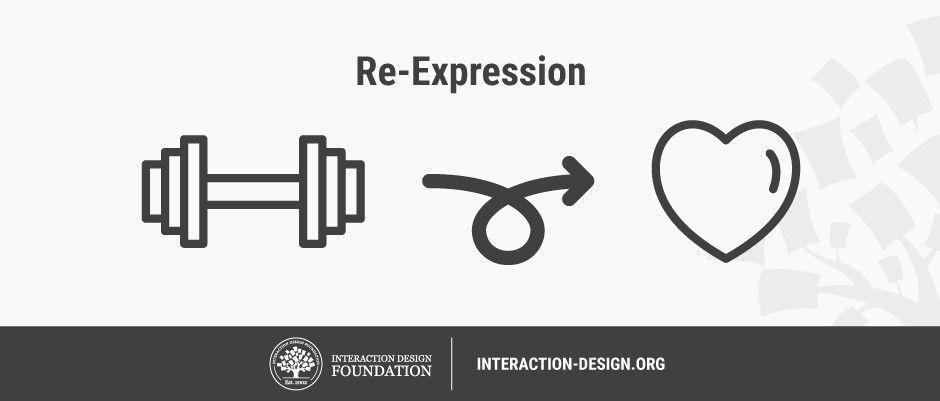
© Teo Yu Siang and Interaction Design Foundation, CC BY-NC-SA 3.0
The idea behind re-expression is that people in the same business or from the same background often use the same words to describe issues and ideas. When we use the same words many times, they become connected to a lot of associations or schemas. For example, let’s say that your task is to come up with fresh new ideas for improving a fitness app and make it stand out against its competitors. If you think about the word ‘fitness’,you probably have many associations about what fitness is and how you achieve it, especially if you have done your background research properly. Your associations are probably not that different from your competitors’—who, not unpredictably, are also trying to come up with innovative solutions for a fitness app. You might think about fitness centers, fitness trackers, training programmes, and so on.

© gradyreese, CC BY-SA 3.0
When we think about fitness, people from similar backgrounds and businesses tend to have similar associations.
Re-expression is a method to help you think about the challenge in a new and different way that is also different from what your competitors are thinking. This is where the fun really starts. Have you ever heard the phrase “can’t see the wood for the trees”? It means being too close to something to be able to notice aspects of it or even its true identity. So, getting distance on your target subject is vital. The book suggests three ways you can do this:
Re-express in different words. Come up with as many related words or metaphors as possible for the issue (product or service) you are seeking to innovate. The word does not have to mean exactly the same thing; it can be something related (an example for ‘fitness’ could be ‘endurance’, ‘play’, ‘health’, ‘repair’, ‘robustness’, and ‘strength’). Then think about what associations you have for each of the new words. Do some of them inspire your original issue? How? Why?
Re-express in different senses. Another method for bringing about new ways to think about an issue is to use different senses. You could draw it, act it out, or build it in Legos. Expressing it in different senses will allow you to see connections that were not previously obvious. Again, you should figure out how they inspire your original issue. As you’re doing this, ask yourself why each connection links to the issue. For instance, if you’ve drawn a tree with powerful branches and a strong, intricate root system, you may discover that while fitness may mean ‘motion’ to many, there’s no reason it can’t involve ‘nutrition’ and ‘settled in good soil (i.e., lifestyle habits)’, too.
Re-express from another perspective. Try to think about how someone else, with different sensibilities from yours, would think about the issue. E.g., how would a 5-year-old think about fitness?—probably more like play and fun than exercise. And how would a person in a wheelchair think about fitness? Challenging? With envy? With nostalgia? This method is in line with ‘Extreme Personas’. Your assumptions do not need to be an accurate reflection of how the other person would think. The main thing is that imagining another perspective will allow you to see the issue differently, and that’s the key to the enterprise here.
You can download and print our Re-expression template to help you get started using the method:
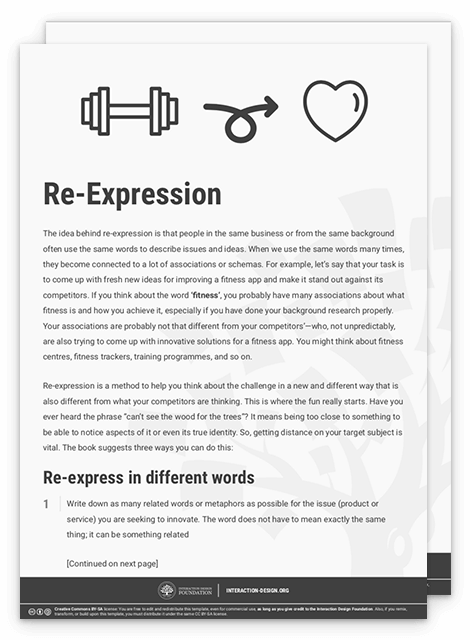

Revolution
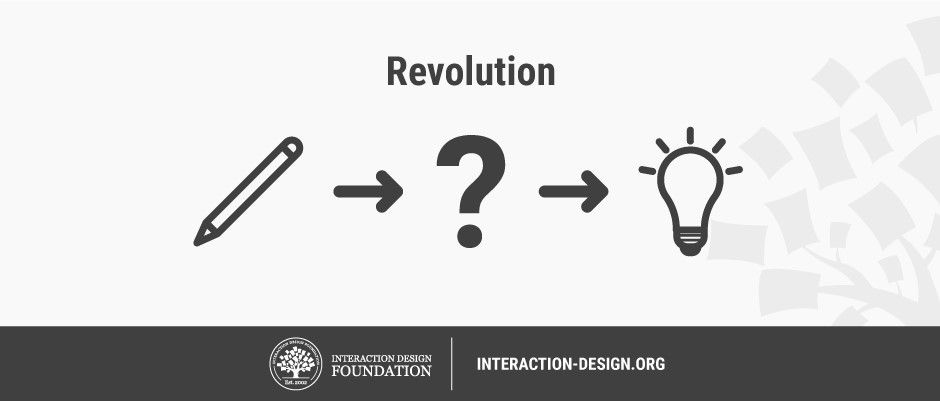
© Teo Yu Siang and Interaction Design Foundation, CC BY-NC-SA 3.0
The way we think about challenges, such as creating an innovative fitness app, is often limited by the rules or attributes we associate with the issue—e.g., how our schemas define fitness. Often, we’re not even consciously aware of the rules and attributes we believe apply to an issue; consequently, challenging our assumptions is difficult. We find a classic, albeit extreme, illustration of that in history books. One reason Christopher Columbus had so much trouble getting financing for his trans-Atlantic voyage was down to the Spanish court’s (along with pretty much everyone else in 1492’s) assumption that it would waste three ships and the lives of those on board. Even though the decision makers humoured Columbus to an extent and put aside the notion that everyone would sail off the edge of the world, another assumption was in the way. Assuming the world was round, as Columbus professed, there was the ‘astronomically vast’ distance involved—‘Why, everyone might starve!’ must have been a predominant fear, therefore. While we can hardly blame the people of the day for clinging to their beliefs—namely, that exploring the unknown would involve doom-welcoming payback—from this, we can see how assumptions can block our visions and be so close to us that recognising them is tricky.
With the Revolution method, you start by writing down as many rules or attributes as you can think of about the issue you are working on. For fitness, rules could be: we move our bodies, and then we ‘do’ fitness; fitness takes place at dedicated places such as outdoors or in fitness centers; you do it to stay in shape, etc.
Once you have identified as many rules as you can think of, you can start challenging these rules by asking ‘what if’ questions. E.g., what if you did not need to go to a dedicated place so as to pursue fitness, but fitness came to you? One answer could be co-working places that include gyms and work-out sessions.
Go through all of the ‘what if’ questions. Can you come up with concrete ideas to answer them? Do they inspire other ideas?
In a way, challenging a rule is the same as creating a new obstruction that you need to work around—because you have created a different rule that requires you to think about things in a new way. The limitation requires you to think differently.
For your inspiration, you can download and print our Revolution template to help you get started using the method:
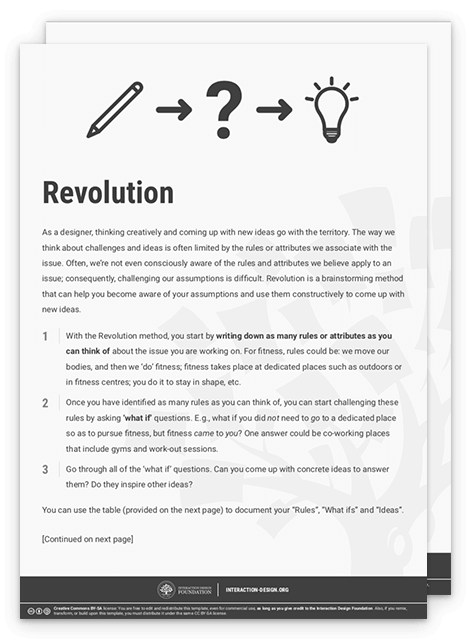

Random Links
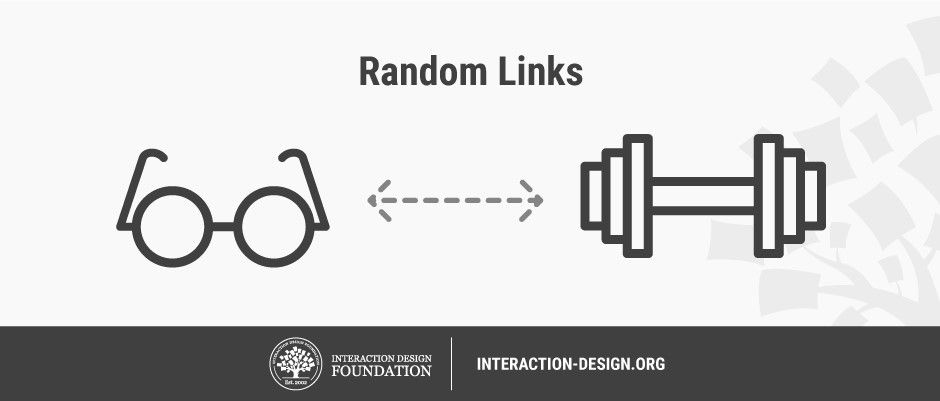
© Teo Yu Siang and Interaction Design Foundation, CC BY-NC-SA 3.0
Random Links is a method that allows you to think more broadly about your challenge. It’s also a means for stretching your imagination and reaching out at some exciting possibilities. The name pretty much says it all; even so, let’s get the deluxe tour, just so we can be sure of exactly how we can apply it.
With Random Links, you pick a random item and force a connection to the issue you are working on. An example could be finding a connection between a case for glasses and fitness. Think about what attributes and associations you relate to a case for glasses: It is something you can bring with you; it can open and close; it protects something fragile; it fits in your hand, etc. It is okay to be abstract about what attributes your random item has.
Then you try to force a connection—i.e., what if you create a fitness app for people who are in some way fragile (e.g., those who are injured, sick, or feeling depressed) to help them feel better and get their strength back.
Within reason, this method can take you to some pricelessly awe-inspiring vantage points. It’s also a great deal of fun, as you get to ‘shoehorn’ concepts over your issue at hand so as to see how well they might fit.
You can download and print our Random Links template to help you get started using the method:
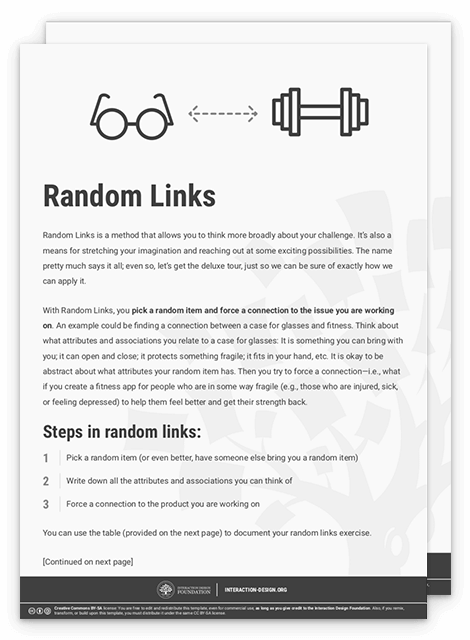


© hermaion, CC0 1.0
Borrowing attributes from a random object—e.g., a case for glasses, will help you approach your challenge in a new way.
The Take Away
The way we think about new information or challenges is often limited by our schemas, or mental slots and shelves into which we categorize items. We tend to overlook new information and new opportunities in favor of making the world fit into the categories that we are used to—which can feel more comfortable but be terribly constraining. Three distinct methods allow you to challenge your usual way of thinking: Re-Expression, Revolution, and Random Links. You can use these when you need to think about an issue differently or to come up with new and innovative ideas. Exploration leads to innovation, and getting those powerful new insights in your future designs can pay massive dividends.
References & Where to Learn More
Dave Allan, Matt Kingdon, Kris Murrin, Daz Rudkin, ?What If!, Sticky Wisdom: How to Start a Creative Revolution at Work, 2002
If you want to learn more about Schema Theory, you can read the classic paper:
David E. Rumelhart, ‘Schemata: the building blocks of cognition’. In: R.J. Spiro et al. (eds) Theoretical Issues in Reading Comprehension, Hillsdale, NJ: Lawrence Erlbaum, 1980
Sandra L. Bem, ‘Gender schema theory: A cognitive account of sex typing’, Psychological Review, Vol 88(4), p 354-364, Jul 1981
Hero Image: © Larry Vincent, CC BY-NC-ND 2.0


